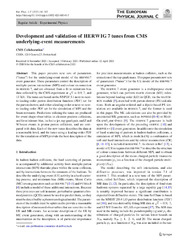Development and validation of HERWIG 7 tunes from CMS underlying-event measurements
| dc.contributor.author | Sirunyan, A. M. | |
| dc.contributor.author | Işıldak, Bora | |
| dc.date.accessioned | 2023-05-11T08:34:54Z | |
| dc.date.available | 2023-05-11T08:34:54Z | |
| dc.date.issued | 2021-04-12 | |
| dc.identifier.issn | 1434-6044 | en_US |
| dc.identifier.uri | http://hdl.handle.net/10679/8241 | |
| dc.identifier.uri | https://link.springer.com/article/10.1140/epjc/s10052-021-08949-5 | |
| dc.description.abstract | This paper presents new sets of parameters (“tunes”) for the underlying-event model of the HERWIG7 event generator. These parameters control the description of multiple-parton interactions (MPI) and colour reconnection in HERWIG7, and are obtained from a fit to minimum-bias data collected by the CMS experiment at s=0.9, 7, and 13Te. The tunes are based on the NNPDF 3.1 next-to-next-to-leading-order parton distribution function (PDF) set for the parton shower, and either a leading-order or next-to-next-to-leading-order PDF set for the simulation of MPI and the beam remnants. Predictions utilizing the tunes are produced for event shape observables in electron-positron collisions, and for minimum-bias, inclusive jet, top quark pair, and Z and W boson events in proton-proton collisions, and are compared with data. Each of the new tunes describes the data at a reasonable level, and the tunes using a leading-order PDF for the simulation of MPI provide the best description of the data. | en_US |
| dc.description.sponsorship | BMBWF and FWF (Austria); FNRS and FWO (Belgium); CNPq, CAPES, FAPERJ, FAPERGS, and FAPESP (Brazil); MES (Bulgaria); CERN; CAS, MoST, and NSFC (China); COLCIENCIAS (Colombia); MSES and CSF (Croatia); RIF (Cyprus); SENESCYT (Ecuador); MoER, ERC PUT and ERDF (Estonia); Academy of Finland, MEC, and HIP (Finland); CEA and CNRS/IN2P3 (France); BMBF, DFG, and HGF (Germany); GSRT (Greece); NKFIA (Hungary); DAE and DST (India); IPM (Iran); SFI (Ireland); INFN (Italy); MSIP and NRF (Republic of Korea); MES (Latvia); LAS (Lithuania); MOE and UM (Malaysia);BUAP, CINVESTAV, CONACYT, LNS, SEP, and UASLP-FAI (Mexico); MOS (Montenegro); MBIE (New Zealand); PAEC (Pakistan); MSHE and NSC (Poland); FCT (Portugal); JINR (Dubna); MON, RosAtom, RAS, RFBR, and NRC KI (Russia); MESTD (Serbia); SEIDI, CPAN, PCTI, and FEDER (Spain); MOSTR (Sri Lanka); Swiss Funding Agencies (Switzerland); MST (Taipei); ThEPCenter, IPST, STAR, and NSTDA (Thailand); TUBITAK and TAEK (Turkey); NASU (Ukraine); STFC (United Kingdom); DOE and NSF (USA). Individuals have received support from the Marie-Curie programme and the European Research Council and Horizon 2020 Grant, contract Nos. 675440, 724704, 752730, and 765710 (European Union); the Leventis Foundation; the A.P. Sloan Foundation; the Alexander von Humboldt Foundation; the Belgian Federal Science Policy Office; the Fonds pour la Formation a la Recherche dans l'Industrie et dans l'Agriculture (FRIA-Belgium); the Agentschap voor Innovatie door Wetenschap en Technologie (IWT-Belgium); the F.R.S.-FNRS and FWO (Belgium) under the "Excellence of Science - EOS" - be.h project n. 30820817; the Beijing Municipal Science & Technology Commission, No. Z191100007219010; the Ministry of Education, Youth and Sports (MEYS) of the Czech Republic; the Deutsche Forschungsgemeinschaft (DFG) under Germany's Excellence Strategy - EXC 2121 "Quantum Universe" - 390833306; the Lendulet ("Momentum") Programme and the Janos Bolyai Research Scholarship of the Hungarian Academy of Sciences, the New National Excellence Program uNKP, the NKFIA research grants 123842, 123959, 124845, 124850, 125105, 128713, 128786, and 129058 (Hungary); the Council of Science and Industrial Research, India; the HOMING PLUS programme of the Foundation for Polish Science, cofinanced from European Union, Regional Development Fund, the Mobility Plus programme of the Ministry of Science and Higher Education, the National Science Center (Poland), contracts Harmonia 2014/14/M/ST2/00428, Opus 2014/13/B/ST2/02543, 2014/15/B/ST2/03998, and 2015/19/B/ST2/02861, Sonata-bis 2012/07/E/ST2/01406; the National Priorities Research Program by Qatar National Research Fund; the Ministry of Science and Higher Education, project no. 02.a03.21. 0005 (Russia); the Tomsk Polytechnic University Competitiveness Enhancement Program; the Programa Estatal de Fomento de la Investigacion Cientifica y Tecnica de Excelencia Maria de Maeztu, grant MDM-2015-0509 and the Programa Severo Ochoa del Principado de Asturias; the Thalis and Aristeia programmes cofinanced by EU-ESF and the Greek NSRF; the Rachadapisek Sompot Fund for Postdoctoral Fellowship, Chulalongkorn University and the Chulalongkorn Academic into Its 2nd Century Project Advancement Project (Thailand); the Kavli Foundation; the Nvidia Corporation; the SuperMicro Corporation; the Welch Foundation, contract C-1845; and the Weston Havens Foundation (USA). | |
| dc.language.iso | eng | en_US |
| dc.publisher | Springer | en_US |
| dc.relation.ispartof | The European Physical Journal C | |
| dc.rights | openAccess | |
| dc.rights.uri | https://creativecommons.org/licenses/by/4.0/ | |
| dc.title | Development and validation of HERWIG 7 tunes from CMS underlying-event measurements | en_US |
| dc.type | Article | en_US |
| dc.description.version | Publisher version | en_US |
| dc.peerreviewed | yes | en_US |
| dc.publicationstatus | Published | en_US |
| dc.contributor.department | Özyeğin University | |
| dc.contributor.authorID | (ORCID 0000-0002-0283-5234 & YÖK ID 124605) Işıldak, Bora | |
| dc.contributor.ozuauthor | Işıldak, Bora | |
| dc.creator | The CMS Collaboration | |
| dc.identifier.volume | 81 | en_US |
| dc.identifier.issue | 4 | en_US |
| dc.identifier.wos | WOS:000639810800002 | |
| dc.identifier.doi | 10.1140/epjc/s10052-021-08949-5 | en_US |
| dc.identifier.scopus | SCOPUS:2-s2.0-85104366975 | |
| dc.relation.publicationcategory | Article - International Refereed Journal - Institutional Academic Staff |
Files in this item
This item appears in the following Collection(s)
Share this page




